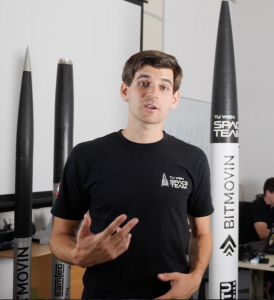Wenn unsere Rakete so funktioniert wie wir es erwarten, erreichen wir eine Höhe, die jenseits der „von Karman-Linie“ liegt. Eine Rakete, die auf die gewünschte Höhe fliegen muss, erfährt einige Belastungen, die für tiefere Testflüge nicht berücksichtigt werden müssen. Dazu gehören unter Anderem die mechanischen und thermischen Beanspruchungen bei Hyperschallgeschwindigkeiten, die Motorzündung unter vermindertem Druck und die Erkennung des Gipfelpunktes im Vakuum. Um diese Probleme zu überwinden, benötigten viele Komponenten ein spezielles Design.
Unser Chief Engineer Andreas Bauernfeind, wird euch von der Konstruktion, Herstellung und dem Testen unserer Rakete berichten.
 “Hi, my name is Andreas Bauernfeind and I’m a mechanical engineer. For more than 3 years I am a member of the “TU Wien Space Team”. Currently I am the vice president and the head of mechanics in our project “the Hound”. As head of mechanics, I am responsible for the design, manufacturing and assembling of our rocket.
“Hi, my name is Andreas Bauernfeind and I’m a mechanical engineer. For more than 3 years I am a member of the “TU Wien Space Team”. Currently I am the vice president and the head of mechanics in our project “the Hound”. As head of mechanics, I am responsible for the design, manufacturing and assembling of our rocket.
Today I want to talk about two topics. The first topic is about the components of our rocket, the second one deals with the test flights that we have already performed. As we have already mentioned before, we have a two-staged design. Each stage has the same design principle. The biggest a heaviest parts are the motor casings, which are also part of the airframe. The outside diameter is equal to the biggest diameter of our rocket. On the bottom of our rocket we mount the fin can and the tail cone, on top of the motor casing there is the electronic bail. The drogue and the parachutes are placed inside the nose cone.
The most interesting parts of our rocket are the aluminum 3D printed fin cans and the airframe of the upper stage. This airframe is made out of high temperature, glas fiber reinforced polymers. Both parts are necessary because the upper stage has to withstand high temperatures at hypersonic speeds.
 The second topic I want to talk about are test flights. Up to date we have performed 5 test flights, one single-stage and four two-stage flights. During the testing, two major issued occurred. The ignition of the upper stage turned out to be more difficult than expected, this event is crucial for a high altitude flight. The other problem was mal function of the booster. In one of our test flights, the parachutes deployed during the staging. The parachutes got damaged and the booster landed hard. The electronics have been a little bit toasty, but with minor changes we could fix the damage*.
The second topic I want to talk about are test flights. Up to date we have performed 5 test flights, one single-stage and four two-stage flights. During the testing, two major issued occurred. The ignition of the upper stage turned out to be more difficult than expected, this event is crucial for a high altitude flight. The other problem was mal function of the booster. In one of our test flights, the parachutes deployed during the staging. The parachutes got damaged and the booster landed hard. The electronics have been a little bit toasty, but with minor changes we could fix the damage*.
Besides this test flights we have already tested our electronic revisions on other rockets. In total we have performed more than 15 test flights in the past two years. You can watch most of the videos on our youtube channel.”
*Achtung, Sarkasmus!